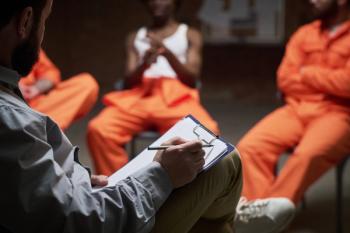
- Psychiatric Times Vol 29 No 1
- Volume 29
- Issue 1
The “Pseudocommando” Mass Murderer: A Blaze of Vainglory
The term “pseudocommando” was first used to describe the type of mass murderer who plans his actions “after long deliberation,” and who kills indiscriminately in public during the daytime.
The term “pseudocommando” was first used to describe the type of mass murderer who plans his actions “after long deliberation,” and who kills indiscriminately in public during the daytime.
2
He comes prepared with a powerful arsenal of weapons and has no escape planned. He is sometimes described as having the intent to die in a “blaze of glory.” Since
glory
has been defined as “a state of great gratification or exaltation,” the clich
to go out in a blaze of glory
would seem to be a perverse turn of phrase, considering the unfathomable pain and tragedy these individuals cause. This article briefly explores what is known about the mindset of the pseudocommando mass murderer and how he transforms his desire for revenge into a perverse sense of honor, which allows him to justify his actions.
On July 22, 2011, Norway experienced the immeasurable fallout from a pseudocommando whose perverted sense of honor and grandiose narcissism obliterated more than 70 innocent people. Anders Behring Breivik, a 32-year-old Norwegian extremist perpetrated a dual attack in Norway: the bombing of government buildings in Oslo that resulted in 8 deaths, and the mass shooting at a camp of the Workers’ Youth League of the Labour Party on the island of Utoya where he killed 69, most of whom were teenagers.3 Breivik composed a 1492-page manifesto he published hours before his attack.4 He was apprehended alive, and his mental state was being examined as this article was being written. After his capture, Breivik requested to be evaluated by Japanese mental health experts because “the Japanese understand the concept of honor better than the Europeans [emphasis added].”
Research
Mass killings by such individuals are not new. The news media tend to suggest that the era of mass public killings began in the 1960s, ushered in by Charles Whitman atop the University of Texas at Austin tower, and henceforward became “a part of American life in recent decades.5” But research suggests that news media have heavily influenced the public perception of mass murder-particularly the inaccurate assertion that its incidence is increasing.6 It is typically the high-profile cases that represent the most widely publicized yet least representative mass killings.
The research on pseudocommandos suggests that they are driven by strong feelings of anger and resentment, in addition to having paranoid character traits. Dietz2 described these individuals as “collectors of injustice” who hold onto every perceived insult, amassing a pile of “evidence” that they have been grossly mistreated. To sustain the revenge “romance,” they must corral the unwanted, hated, or feared aspects of themselves. This collection is then re-assembled into the form of an “enemy” who “deserves” to be the target of a merciless, incendiary rage. Thus, the pseudocommando maintains object relations with others, which are heavily based on envy and splitting.
. . . as I’m rushing through my city, guns blazing, with 100 armed system protectors pursuing me . . . I know there is a 80%+ chance I am going to die during the operation. . . .
-Breivik1
Mullen7 described the results of his detailed forensic evaluations of 5 pseudocommando mass murderers who were caught before they could kill themselves or be killed. Mullen noted that the massacres were often well planned out (ie, the offender did not suddenly “snap”): the offender arrived at the crime scene well-armed, often in camo or “warrior” gear. He appeared to be pursuing a highly personal agenda of “payback.” Mullen’s study also found a number of traits and historical factors that these individuals had in common: They were bullied or isolated as children and had become “loners” who felt despair over being socially excluded. They were also described as being resentful grudge holders who demonstrated obsessional or rigid traits. (The
Narcissistic, grandiose traits were present, along with heavy use of externalization. They held a generally disparaging view of others, which resulted in spending a great deal of time ruminating on past humiliations. The ruminations evolved into fantasies of violent revenge, to the point that the offenders seemed to “welcome death,” even perceiving it as bringing them “fame” with an aura of power. Most of the literature references the pseudocommando’s motivation of revenge, which may be directed at a group (pseudocommunity) or representative ideology.2,7,8
The revenge romance
He piled upon the whale’s hump the sum of all the general rage and hate . . . and then, as if his chest had been a mortar, he burst his hot heart’s shell upon it.
-Herman Melville, Moby Dick9
The desire for revenge “is a ubiquitous response to narcissistic injury.10” Greek mythology is replete with revenge themes.11 Revenge is the central motive in at least 20 of Shakespeare’s plays and the main theme in many of today’s Hollywood movies (eg, the “Death Wish” series and, more recently, the “Kill Bill” series, which highlight our fascination with “the sweet taste of payback”).12 Across almost every culture, the taking of revenge, when “justified,” has assumed “the status of a sacred obligation.13” In many cultures since biblical times and before, there has at least been the restraining notion of functional symmetry in seeking redress, such as the Old Testament’s admonition of “an eye for an eye.”
At this stage of our evolution, affronts to our self-esteem or narcissism are responded to as though they were a threat to our survival.14 We have maintained the physiological hard-wiring, available for excessive use in situations that do not involve survival of the body, but instead survival of the ego.15 In individuals with vulnerable, fragile (perhaps overly inflated) egos, threats to self-esteem may result in the harboring of destructive rage that eventually transforms them into avengers. Indeed, it is the frustration of the need to “preserve a solid sense of self,” that is often “the source of the most fanatical human violence [as well as] the everyday anger that all of us suffer.16”
However, this type of righteous anger is, in reality, a vainglorious pseudopower, because it is merely a reaction to intolerable feelings of powerlessness. Nevertheless, there comes a point when this pseudopower is the only defense the avenger has left to ward off the annihilation of his sense of self. This is why, when the potential avenger’s ego is threatened or hurt “in such a devastating way . . . the only thing that remains is to persist in the ‘unremitting denunciation of injustice.’” At this point, it becomes almost impossible for him to give up on the “crusade,” because there is a perverse honor in refusing to normalize the perceived injustice.17
Revealed here is the “hidden logic of the . . . avenger” to sustain a perverse and grandiose “refusal to compromise”; an insistence “against all odds” lest his “heroic” fantasy and fragile ego surrender to the reality of a “self” he finds intolerable.16,17 The revenge fantasies are inflexible and persistent because they provide desperately needed sustenance to the ego. These fantasies may lead the avenger to “experience pleasure at imagining the suffering of the target and pride at being on the side of some spiritual primal justice.” The revenge fantasy gives the “illusion of strength,” and a temporary, although false, sense of restored control and self-coherence.18 The type of severe narcissistic rage experienced “serves the purpose of the preservation of the self” that has exceeded its limit of shame, alienation, and aversive self-awareness.14 This pain and rage cannot be contained by the pseudocommando, who then embarks “on a course of self-destruction that transfers [his] pain to others.”
The revenge fantasy helps the pseudocommando obliterate an intolerable reality and aversive self-awareness. His rumination “dominates thought and impels action much as an addiction or erotomania does.11” The avenger could be said to have “fallen” into romantic/idealized hate. Just as Captain Ahab believed he had been “dismasted” by the whale, he reached the final stages of narcissistic inaccessibility and plunged irretrievably into a downward spiral of reality-destroying nihilism. For those who progress to acting on their violent fantasies, they go beyond denying aversive self-awareness. By stepping across the threshold into an obliterative mindset, the pseudocommando bestows on himself a false authority. His judgment lacks any sense of symmetry, and “an eye for an eye soon gives way to a life for an eye.11”
Obliteration for the glory of . . . me
Shakespeare’s Richard III is a classic example of a mind committed to revenge, driven by powerful grievance. His state of mind may be regarded as an “obliterative state of mind,” in that it functions to spread more grievance, destruction, and ultimately annihilation.19 Individuals committed to revenge may come to embrace a self-styled image based on low self-esteem or negative self-perceptions that may be tinged with an ominous undertone. That is, they embrace their dark, negative cognitions and fashion them into a recognizable suit of “black” armor.
Persons driven by envy and destruction tend to see others “as in the light and [choose] to stay in the dark.19” In the case of Richard III, his inner envy and destructive narcissism lead him to consciously adopt the role of reprobate.20
Toxic levels of “envy and narcissism . . . can fracture the personality, hold it hostage and in thrall, by being fuelled by triumph and contempt.” The developing pseudocommando must hold fast to his “hatred of anything such as growth, beauty, or humanity which is an advance over a bleak, static interior landscape.19” In addition, the pseudocommando may well harbor the notion that “Nature has done me a grievous wrong. . . . Life owes me reparation for this. . . . I may do wrong myself, since wrong has been done to me.21”
It is this feeling of being an exception to the rules, of being justified in harming others, that fuels the pseudocommando’s obliterative state of mind. Once he has embraced this mindset, “he cannot envision rescue from this commitment to a killing field externally or internally.19” The narcissistic injury that is utterly intolerable is “essentially nihilistic: nothing matters, all is despair. . . . all goodness and substance are obliterated, so that nothingness defines the domain.”
For some, the motivational trail may end with obliteration and annihilation. But for others, it is possible that the trail does not end here. For these individuals, there is more to revenge than annihilation. By their behavior and communications, they suggest that they are willing to die so as to not “lose” under any circumstances, their constructed, yet fragile, sense of self. It is not an option to submit or concede that his “heroic” sense of self is not righteous or transcendent. Indeed, to do so amounts to a humiliating, damning reality that exceeds death in its promise of torture.
For comparison, consider the genuine commando-the soldier-who has the notion that he or she may be dying for a greater cause outside of himself or herself. The vengeful pseudocommando must believe his cause is great as well, but in the case of the former, we have altruistic motivations focused on others. In the case of the latter, we see self-concerned motivation and grandiosity. What could be more grandiose than sacrificing oneself-for the glorification of oneself? The subtext would seem to be: “I’ll kill myself so I will never face losing my falsely constructed self-and, I’ll sacrifice many other people’s lives to get what I want.” But of course, in getting what he wants, he must plan, ruminate, and bide his time until he can abruptly go out in a contemptible flame. In doing so, he leaves behind a charred crater of voided humanity as testament to the depth of his self-centeredness.
Future directions
Regarding prevention, the sobering reality is that such events are extremely hard to anticipate and thwart.22 Retrospectively, one sometimes discovers “windows” of opportunity that if taken advantage of, may possibly have represented chances to avoid the tragedy. Such windows may take the form of family members or social contacts who take steps to have the potential pseudocommando evaluated and treated.23 In terms of media response, it is important to have a thoughtful set of reporting guidelines. For example, it has been suggested that news media should avoid glorifying the perpetrator and not disclose his methods or number of victims killed.24 Rather, media should emphasize victim and community recovery efforts and deflect attention away from the perpetrator.
One promising avenue of future research includes studying and understanding the presence of “identification warning behaviors” that may appear and suggest impending or accelerating risk.25
Hempel and colleagues26 were among the first to note that pseudocommandos will often “convey their central motivation in a psychological abstract, a phrase or sentence yelled with great emotion at the beginning of the mass murder.” To date, the actual communications of the pseudocommando mass murderer have received little detailed analysis.8,27 The study of both pre-offense (ie, leaked) and after-the-fact communications may assist in gaining insight into the psychology of the pseudocommando that can inform preventive efforts. Risk assessments of individuals with strong revenge fantasies will have to consider the intensity and quality of the revenge fantasies, vulnerability to ego threats, and relevant biopsychosocial risk variables.15
References:
References
1. Oslo Terrorist Anders Behring Breivik Manifesto.
2. Dietz PE. Mass, serial and sensational homicides. Bull N Y Acad Med. 1986;62:477-491.
3. MinnPost.com. Norway attacks: What happens if Brievik is deemed insane?
4. 2083: A European Declaration of Independence.
5. The Associated Press. Mass public shootings on the rise, but why? While some see connection to guns, others blame erosion of community. April 21, 2007.
6. Duwe G. A circle of distortion: the social construction of mass murder in the United States. West Criminol Rev. 2005;6:59-78.
7. Mullen PE. The autogenic (self-generated) massacre. Behav Sci Law. 2004;22:311-323.
8. Knoll JL 4th . The “pseudocommando” mass murder: part I, the psychology of revenge and obliteration. J Am Acad Psychiatry Law. 2010;38:87-94.
9. Melville H. Moby Dick. London: Random House UK; 2007:chap 41.
10. LaFarge L. The wish for revenge. Psychoanal Q. 2006;75:447-475.
11. Rosen IC. Revenge-the hate that dare not speak its name: a psychoanalytic perspective. J Am Psychoanal Assoc. 2007;55:595-620.
12. Cargill CR. Revenge is a dish best served cold. August 30, 2007.
13. Watson L. Dark Nature: A Natural History of Evil. New York: HarperCollins Publishers, Inc; 1995.
14. Menninger WW. Uncontained rage: a psychoanalytic perspective on violence. Bull Menninger Clin. 2007;71:115-131.
15. Baumeister RF, Smart L, Boden JM. Relation of threatened egotism to violence and aggression: the dark side of high self-esteem. Psychol Rev. 1996;103:5-33.
16. Leifer R. Vinegar Into Honey: Seven Steps to Understanding and Transforming Anger, Aggression, and Violence. Ithaca, NY: Snow Lion Publications; 2008.
17. Zizek S. Violence: Six Sideways Reflections. New York: Picador; 2008.
18. Horowitz MJ. Understanding and ameliorating revenge fantasies in psychotherapy. Am J Psychiatry. 2007;164:24-27.
19. Anderson MK. The death of a mind: a study of Shakespeare’s Richard III. J Anal Psychol. 2006;51:701-716.
20. Shakespeare W. The Tragedy of King Richard III.
21. Freud S. The Standard Edition of the Complete Psychological Works of Sigmund Freud. Vol 14. Strachey J, trans-ed. Toronto: The Hogarth Press, Ltd; 1981:314-315.
22. Saleva O, Putkonen H, Kiviruusu O, Lönnqvist J. Homicide-suicide-an event hard to prevent and separate from homicide or suicide. Forensic Sci Int. 2007;166:204-208.
23. Orange R. Anders Behring Breivik’s sister warned mother about his behaviour two years ago.
24. Preti A. School shooting as a culturally enforced way of expressing suicidal hostile intentions. J Am Acad Psychiatry Law. 2008;36:544-550.
25. Meloy JR, Hoffmann J, Guldimann A, James D. The role of warning behaviors in threat assessment: an exploration and suggested typology. Behav Sci Law. August 24, 2011.
26. Hempel AG, Meloy JR, Richards TC. Offender and offense characteristics of a nonrandom sample of mass murderers. J Am Acad Psychiatry Law. 1999;27:213-225.
27. Knoll JL 4th. The “pseudocommando” mass murder: part II, the language of revenge. J Am Acad Psychiatry Law. 2010;38:263-272.
Articles in this issue
almost 13 years ago
Effects of Pharmacokinetic and Pharmacodynamic Changes in the Elderlyalmost 13 years ago
Introduction: The Integrated Approach to Addressing Comorbidities-Part 1almost 14 years ago
Chronic Disease Self-Management Programs in Psychiatryalmost 14 years ago
Educating Patients About Bipolar Disordersalmost 14 years ago
Introduction: Patient Education as Treatment Foundationalmost 14 years ago
Treatment of Insomnia in Anxiety Disordersalmost 14 years ago
Anesthesia Advances Add to Safety of ECTalmost 14 years ago
Unfavorable Changes to Medicare Pay Loom for Psychiatristsalmost 14 years ago
First DateNewsletter
Receive trusted psychiatric news, expert analysis, and clinical insights — subscribe today to support your practice and your patients.

















